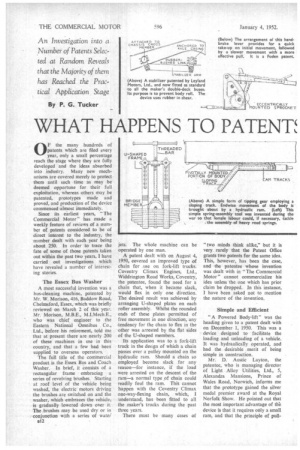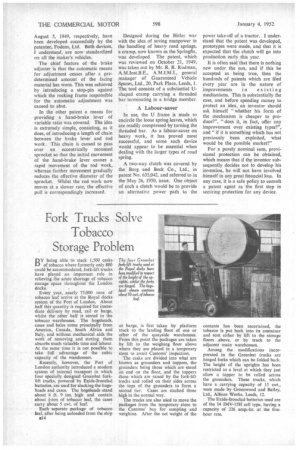WHAT HAPPENS TO PATENT
Page 46

Page 47

Page 48

If you've noticed an error in this article please click here to report it so we can fix it.
An Investigation into a Number of Patents Selected at Random Reveals that the Majority of them has Reached the Practical Application Stage By P. G. Tucker OF the many hundreds of patents which are flied every year, only a small percentage reach the stage where they are fully developed and the ideas absorbed into industry. Many new mechanisms ale covered merely to protect them until such time as may be deemed opportune for their full exploitation, whereas others may be patented, prototypes made and proved, and production of the device commenced almost immediately.
Since its earliest years, "The Commercial Motor" has made a weekly feature of reviews of a number of patents considered to be of direct interest to the industry, the number dealt with each year being about 250. In order to trace the fate of some of those patents taken out within the past two years, I have carried out investigations which have revealed a number of interesting stories.
The Essex Bus Washer A most successful invention was a bus-cleaning machine, patented by Mr. W. Morison, 416, Baddow Road, Chelmsford, Essex, which was briefly reviewed on March 2 of this year. Mr. Morison, M.13.E., M.I.Mech.E., who was chief engineer to the Eastern National Omnibus Co., Ltd., before his retirement, told me that at present there are nearly 200 of these machines in use in this country, and that a few had been supplied to overseas operators.
The full title of the commercial product is the Essex Bus and Coach Washer. In brief, it consists of a rectangular frame embracing a series of revolving brushes. Starting at roof level of the vehicle being washed, the electric motors driving the brushes are switched on and the washer, which embraces the vehicle, is gradually lowered down over it. The brushes may be used dry or in conjunction with a series of water.
B12 jets. The whole machine can be operated by one man.
A patent dealt with on August 4, 1950, covered an improved type of chain for use on fork-lift trucks. Coventry Climax Engines, Ltd., Widdrington Road Works, Coventry, the patentee, found the need for a chain that, when it became slack, would flex in only one direction. The desired result was achieved by arranging U-shaped plates on each roller assembly. Whilst the rounded ends of these plates permitted of free movement in one direction, any tendency for the chain to flex in the other was arrested by the flat sides of the U-shaped members.
Its application was to a fork-lift truck in the design of which a chain passes over a pulley mounted on the hydraulic ram. Should a chain so employed become slack for any reason—for instance, if the load were arrested on the descent of the ram—a normal type of chain could readily foul the ram. This cannot happen with the Coventry Climax one-way-flexing chain, which, I understand, has been fitted to all the maker's trucks during the past three years.
There must be many cases of "two minds think alike," but it is very, rarely that the Patent Office grants two patents for the same idea. This, however, has been the case, and the patentee whose invention was dealt with in "The Commercial Motor" cannot commercialize his idea unless the one which has prior claim be dropped. In this instance, I have been asked not to mention the nature of the invention.
Simple and Efficient
"A Powered Body-lift" was the heading given to a patent dealt with on December 1. 1950. This was a device designed to facilitate the loading and unloading of a vehicle. It was hydraulically operated, and had the desirable .merit of being simple in construction.
Mr. D. Austic Layton, the patentee, who is managing director of Light Alloy Utilities, Ltd., 5, Alexandra Mansions, Prince of Wales Road, Norwich, informs me that the prototype gained the silver medal premier award at the Royal Norfolk Show. He pointed out that the most important advantage of the device is that it requires only a small ram, and that the principle of pull ing the load up a slope makes for high efficiency.
A steering mechanism intended for vehicles having an independent front-wheel suspension system was reviewed on December 8, 1950. Lieut.-Col. R. H Johnston, 0.B E., Flowton Priory, Harpenden, one of the patentees, says of the idea: "In its present form it is unlikely that the patent would be useful, but it represents a new principle, and development along the same lines might make it of value."
A Roller " Chain " The new principle to which he refers is that of a series of rollers arranged in a closed circuit, movement of the rollers being effected by a sprocket-like member mounted on the end of the steering column.
Col. Johnston says, further, that the normal procedure adopted by Mr. R Bishop, the co-patentee, and himself is to bring the idea to the prototype stage and then wait until there appears to be an application to which it might be peculiarly suited.
Using rubber in shear, Leyland Motors, Ltd., patented a stabililizer, which was briefly reviewed on January 19 last. The purpose of this device was to prevent body roll on the maker's double-deck buses.
I am told that the unit has proved successful, and that it has been fitted as standard to all Leyland doubledeck machines produced during the past three years. When, however. a customer specifies shock absorbers at the rear, then the stabilizer is not fitted, as it is not the practice of the company to fit both.
As another instance of an idea being covered by a patent in order to protect it for possible application at some future date, there is the electrically controlled gearbox patented by Morris Motors, Ltd., and dealt with in "The Commercial Motor" on January 19 of this year. The basis of the idea was the use of magnetic clutches mounted in dual flywheels. The gearbox was intended to be a combination of epicyclic and ordinary pinion gears.
Inquiries made in connection with this patent reveal that the idea has not even been tried out experimentally.
A warning device for use-on the platform of a bus formed the subject matter of a patent taken out by Mr. G. Rock, MINIM-LE., Northfield,
Saxilby, Lincs. 11 was reviewed on February 10, 1950, and the details revealed that it consisted of a rubber sleeve lined with metal strips or wires insulated from a central, tubular metal member.
Applied to a Bus This unit was . intended to be mounted at appropriate heights on the handrail of a bus, so that the hand of an alighting or boarding passenger would automatically encircle and grip the tube. This action would close an electric circuit, the switch action being utilized to light a lamp, cause a buzzer to sound or a bell to ring.
Mr. Rock, who, until his, retirement, was general manager and engineer to Lincoln Corporation transport undertaking, says that other than on Lincoln buses and some Glasgow passenger vehicles, little interest has been shown in his idea, despite the fact that the results obtained in service have been most satisfactory.
Two improvements, one covering hand-brake mechanism, and the other an automatic adjuster for brakes, reviewed on February 24, 1950, and
August 5, 1949, respectively, have been developed successfully by the patentee, Fodens, Ltd. Both devices, I understand, are now standardized on all the maker's vehicles.
The chief feature of the brake adjuster is that the automatic means for adjustment ceases after a predetermined amount of the facing material has Worn. This was achieved by introducing a stop-pin against which the rocking frame responsible for the automatic adjustment was caused to abut.
In the other patent a means for providing a hand-brake lever of variable ratio was covered. The idea is extremely simple, consisting, as it does, of introducing a length of chain between the brake lever and rod work. This chain is caused to pass over an eccentrically mounted sprocket so that the initial movement of the hand-brake lever causes a rapid movement of the rod work, whereas further movement gradually reduces the effective diameter of the sprocket. Whilst the rod work now moves at a slower rate, the effective pull is correspondingly increased. Designed during the Hitler war with the idea of saving manpower in the handling of heavy road springs, a cramp, now known as the Springfix, was developed. The patent, which was reviewed on October 21, 1949, was taken out by Mr. R. R. Rud man, A.M.1nst.B.E., A.M.I.M.I., general manager of Guaranteed Vehicle Spares, Ltd., 20, Park Place, Leeds, 1. The tool consists of a substantial Ushaped cramp carrying a threaded bar terminating in a bridge member.
A Labour-saver In use, the U frame is made to encircle the loose spring leaves, which are readily compressed by turning the threaded bar. As a labour-saver on heavy work, it has proved most successful, and some such device would appear to be essential when dealing with the larger types of road spring.
A two-way clutch was covered by the Borg • and Beck Co., Ltd., in patent No. 635,042, and referred to in the May 26, 1950, issue. One object of such a clutch would be to provide an alternative power path to the power take-off of a tractor. I understand that the patent was developed, prototypes were made, and that it is expected that the clutch will go into production early this year.
It is often said that there is nothing new under the sun, and if this be accepted as being true, then the hundreds of patents which are filed every year are in the nature of improvements in existing mechanisms. This is substantially the ease, and before spending money to protect an idea, an inventor should ask himself "whether his form of the mechanism is cheaper to produce?", "does it, in fact, offer any improvement over existing types?", and "if it is something which has not previously been exploited, what would be the possible market?"
For a purely nominal sum, provisional protection can be obtained, which means that if the inventor subsequently decides not to develop his invention, be will not have involved himself in any great financial loss. In any case, it is a safe policy to consult a patent agent as the first step in securing protection for any device.




















































































